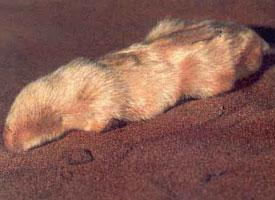
Weights and measures
| Length | from 12 to 18 cm |
|---|---|
| Weight | from 40 to 70 g |
| Tail lenght | from 2 to 2,5 cm |
State of endangerment
| Endangered |
Animal description
The Southern marsupial mole, scientifically known as Notoryctes typhlops, is an intriguing and enigmatic creature native to the arid and sandy deserts of central and western Australia. This small, elusive mammal is part of the Notoryctidae family, which comprises just two species, both of which are adapted to a life spent predominantly underground.Physically, the Southern marsupial mole is an extraordinary example of adaptation to a subterranean lifestyle. It possesses a cylindrical body covered in soft, fine fur that ranges in color from creamy yellow to a more golden hue, allowing it to blend seamlessly with the sandy environments it inhabits. One of the most distinctive features of this animal is its lack of functional eyes. Over evolutionary time, the Southern marsupial mole has developed small, vestigial eyes covered by a layer of skin and fur, a testament to its life spent almost entirely underground where vision is unnecessary.
The creature's head is conical, equipped with a leathery, pointed snout that serves as an efficient tool for burrowing through the sand. Its nostrils are protected by special shields that prevent sand from entering while it digs. The Southern marsupial mole's limbs are another marvel of evolutionary adaptation. Its forelimbs are particularly robust, with large, spade-like claws designed for digging, while its hind limbs are smaller and less developed, used primarily for pushing soil backward as it moves through its subterranean tunnels.
One of the most fascinating aspects of the Southern marsupial mole is its unique method of locomotion, often described as "swimming through the sand." This animal can move forward and backward with equal ease, navigating through its sandy environment in search of food. Its diet primarily consists of insects, larvae, and occasionally small reptiles and vegetation, which it detects through sensitive vibrations and a keen sense of smell.
Despite being a mammal, the Southern marsupial mole exhibits some reptilian characteristics, such as a low metabolic rate and an ability to withstand high temperatures, both crucial for surviving in the harsh desert climate. This mole is also a solitary creature, coming together with others only to mate. Due to its elusive nature and subterranean habitat, much about its reproductive behavior remains a mystery, though it is known to be a marsupial, with females possessing a backward-opening pouch where the young, called joeys, are nurtured until they can survive independently.
The conservation status of the Southern marsupial mole has been difficult to ascertain due to its secretive nature and the challenging terrain of its habitat. It is considered rare, and sightings are uncommon, making it difficult for researchers to study and protect this unique species. Threats to its survival include habitat destruction due to mining and land clearing for agriculture, as well as predation by introduced species such as foxes and feral cats.
In summary, the Southern marsupial mole is a remarkable creature, perfectly adapted to its underground existence in the Australian desert. Its life remains largely a mystery, hidden beneath the sands, but what is known showcases the incredible diversity of life and the power of evolutionary adaptation.
New photos of animals
Top 10 animals
- Dolphin gull (Leucophaeus scoresbii)
- Diana monkey (Cercopithecus diana)
- Moustached guenon (Cercopithecus cephus)
- Galápagos tortoise (Geochelone nigra complex)
- Stone loach (Barbatula barbatula)
- Greek tortoise (Testudo graeca)
- Japanese macaque (Macaca fuscata)
- Russian tortoise (Testudo horsfieldii)
- Common flying dragon (Draco volans)
- Galápagos penguin (Spheniscus mendiculus)